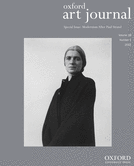-
Views
-
Cite
Cite
Jorge Ribalta, The Strand Symptom: A Modernist Disease?, Oxford Art Journal, Volume 38, Issue 1, March 2015, Pages 55–71, https://doi.org/10.1093/oxartj/kcu030
Close - Share Icon Share
Extract
A Symptom
What follows is a sketch for a political reading of Paul Strand. It addresses a specific structural contradiction in his work between revolutionary politics and conservative aesthetics. This contradiction, I argue, demonstrates an ahistorical understanding of the working class or, to be more exact, a misunderstanding of the pre-war documentary project carried out by the Worker Photography Movement since 1926, in which Strand participated. This structural contradiction between Strand's politics and his work, which I am calling the ‘Strand symptom’, had major consequences for the post-war humanist reframing and de-politicisation of documentary discourse.
Strand's commitment to the political project of Worker Photography can be traced back to 1932, when he left New York for Mexico and worked as the Director of Photography on Redes (The Wave) (1934), a film about working class struggles in a small fishing village. Back in New York in 1935, after a brief trip to Moscow, Strand, along with Leo Hurwitz and Ralph Steiner, founded Nykino, an offshoot of the Workers Film and Photo League.1 One year later, in 1936, with Hurwitz, Strand organised a new film collective, Frontier Films, which produced some of the most important films of the Popular Front, including Heart of Spain (1938–1940) and Native Land (1938–1942). In 1938, he joined the Photo League, as an advisor and a lecturer. That year, Strand also produced one of the most ‘monstrous’ images of the workers' movement: his skeletal crucifixion (Fig. 1). This bizarre image will serve as the crux for this discussion of the Strand ‘symptom’ and the contradiction between iconography and politics at the centre of the American Worker Photography Movement evolution.



